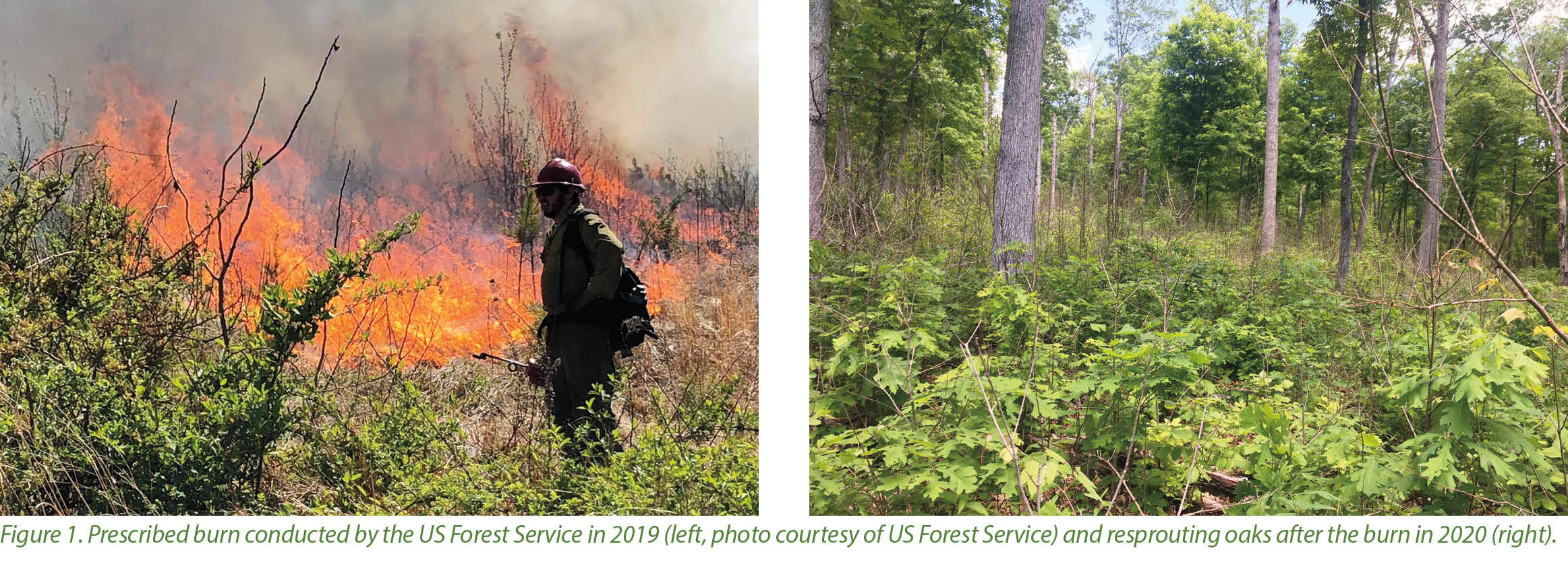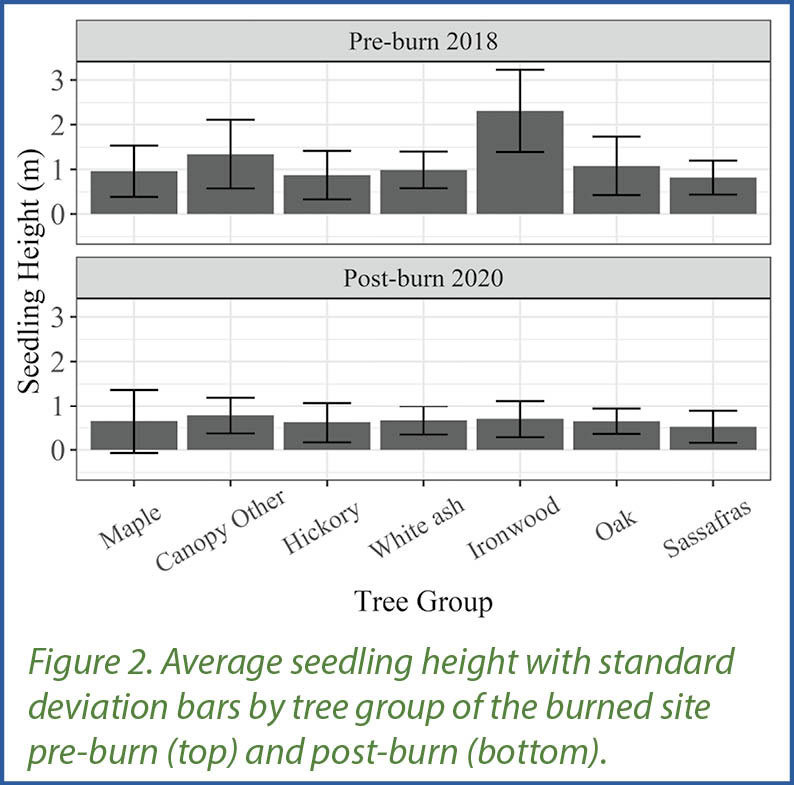Using Harvests and Fire to Promote Oak Reproduction
in Dry Upland Forests
Oak (Quercus spp.) forests in the eastern United States provide valuable wildlife habitat, timber resources, and carbon storage. They are fire-adapted ecosystems that, historically, were maintained by frequent, low-intensity burns. Oak trees have many fire adaptations, including thick bark, compartmentalization of wounds, underground germination, and prolific resprouting after fire (Brose et al. 2001, 2014). However, oak forests are in decline due to fire suppression that started in the early 1900s, under which wildfires were extinguished and prescribed fires were not implemented. This lack of fire on the landscape has led to a shift in tree species as oak forest understories became densely shaded and underwent the process of mesophication. Mesophication occurs when shade-tolerant, but fire-intolerant, tree species such as maples (Acer spp.) begin to replace drought and fire-tolerant, but shade-intolerant, species such as oaks (Brose et al. 2001, Nowacki and Abrams 2008). These shade-tolerant and fire-sensitive species commonly outcompete oak seedlings and saplings, leading to fewer mature oak trees in the future. Without intervention, the abundance of oak trees will continue to decline as they are unable to successfully reproduce and are replaced by other species.
Forest managers and landowners often want to know how to maintain oaks on their property, but before they start management, they need to understand that not all oak forests are the same. Differences in oak forests are largely driven by differences in moisture availability, with more productive mesic sites (sites with greater water availability) undergoing more severe mesophication that makes it difficult to restore oak species. Dry sites are less productive and experience a slower rate of mesophication. On dry sites, forests may shift from one species of oak to another species of oak that is slightly more tolerant of shade (Olson et al. 2014)most of these studies were conducted in the eastern and central CHR, and the assumption that similar dynamics occur in the western CHR has not been fully substantiated. We investigated forest dynamics in relatively undisturbed, mature oak-hickory forests of the Missouri Ozarks during a 15-year period (1995-2010. Therefore, it is often easier and more cost-effective to maintain oak on these drier, less productive sites because promoting new oak seedlings requires less management effort.
A management technique that is often used to promote oak is the shelterwood-burn method, which includes an initial shelterwood cut removing unwanted tree species and leaving mostly dominant and codominant oaks and hickories (Carya spp.) in the overstory, in conjunction with a midstory removal (Brose et al. 1999). The reduction in overstory and midstory trees allows for more light to reach the oak seedlings, reducing light competition with undesirable species. Three to five years later, once the oak seedlings are large enough to survive fire, a prescribed burn is applied to the site to reduce competition in the seedling layer and reduce the depth of the litter layer, which allows acorns to germinate.
A study was initiated in 2010 on the Hoosier National Forest in southern Indiana to evaluate the effectiveness of different tree harvesting and burn treatments on two sites. One site was drier and less productive and received the shelterwood-burn treatment with overstory and midstory harvests conducted during 2012- 2015 and the burn in April 2019. The other site was more productive and received an initial shelterwood cut and midstory removal during 2011-2013, but was not burned. During and after treatments, the survival and growth of individually tagged seedlings were tracked in addition to tallying tree seedlings and saplings by species at both sites.
Results indicate that oaks seedlings performed better at the drier, less productive site after receiving the shelterwood-burn. After the prescribed burn, oak species had an average survival rate above 90%. While fire may have top-killed surviving oak seedlings, they resprouted vigorously (Figure 1), which is an important fire adaptation of oak species. Non-oak species, such as maples, white ash (Fraxinus americana), and ironwood (Ostrya virginiana) had an average survival rate of 75% or less in 2020. As with oak, surviving seedlings of competing species resprouted after the fire. The average height of oak seedlings before the burn was 13% shorter than that of non-oak species (1.19 m compared to 1.35 m, respectively). However, after burning, the heights of survivors were more similar between oak and non-oak species, 0.69 m vs. 0.71 m (a 3% difference), respectively. (Figure 2). Because burning reduced the difference in height between oak and non-oak species, the competitive advantage of non-oak species was similarly reduced. Following the burn, white ash seedlings were most abundant (133 stems per 100 m2), followed by white oak (Q. alba, 99 stems per 100 m2), and ironwood (69 stems per 100 m2). The number of oak seedlings doubled after the fire, while non-oak species on average were only 1.6 times more abundant. The positive response of oak seedlings at the burned site supports the Forest Service plan to remove the remaining overstory trees from the shelterwood areas to further release the oak seedlings.
In comparison, oaks at the more productive site were not at a competitive advantage with ironwood having the tallest average seedling height at 2.6 m, which was more than twice the height of white oak at 1.1 m (Figure 2). Other species also had a greater average seedling height than the oaks, including red maple (A. rubrum) and sugar maple (A. saccharum). As with the burned site, white ash seedlings were most abundant (73 stems per 100 m2), followed by white oak (60 stems per 100 m2), and red maple (45 stems per 100 m2). Throughout the unburned experiment, the average number of oak seedlings did not improve significantly compared to pretreatment numbers. Non-oak seedling abundance also remained consistent throughout the treatments. Overall, the response of oak seedlings at the unburned site was much less positive than that at the burned site.
Woodland landowners and managers can apply shelterwood cuts with midstory removal and fire to their property if site conditions are appropriate and they have an adequate number of oak seedlings and saplings before treatments. A single burn was adequate to promote oak reproduction on our less productive site. However, at our more productive site, multiple fires would be needed to promote oak reproduction and reduce competition from non-oak species. For this reason, landowners may wish to focus oak restoration efforts on their less productive or drier sites where fewer burns and less time are needed to promote competitive oak seedlings. These drier oak forests are typically located on south slopes and ridges in the south-central region of Indiana. While harvesting and fire can be used to maintain and restore oak forests, other factors, such as heavy deer browse and invasive species, can affect the reproduction and survival of oak species and should be considered in management plans.
Literature Cited
Brose, P. H., D. C. Dey, and T. A. Waldrop. 2014. The fire-oak literature of eastern North America: synthesis and guidelines. NRS-GTR-135. U.S. Department of Agriculture, Forest Service, Northern Research Station, Newtown Square, PA.
Brose, P. H., D. H. Van Lear, and P. D. Keyser. 1999. A Shelterwood—Burn Technique for Regenerating Productive Upland Oak Sites in the Piedmont Region. Southern Journal of Applied Forestry 23:158–163.
Brose, P., T. Schuler, D. V. Lear, and J. Berst. 2001. The Changing Regimes of the Appalachian Mixed-Oak Forests. Journal of Forestry:30–35.
Nowacki, G. J., and M. D. Abrams. 2008. The Demise of Fire and “Mesophication” of Forests in the Eastern United States. BioScience 58:123–138.
Olson, M. G., A. P. Stevenson, B. O. Knapp, J. M. Kabrick, and R. G. Jensen. 2014. Is There Evidence of Mesophication of Oak Forests in the Missouri Ozarks? Proceedings of the 19th Central Hardwood Forest Conference:139–153.
Sarah Rademacher is a Master’s student in the Department of Forestry and Natural Resources at Purdue University (FNR)
studying the impacts of overstory manipulation and reintroduction of fire on oak forests on the Hoosier National Forest. Mike Jenkins is an Associate Professor of Forest Ecology in FNR.
